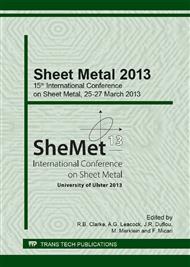p.172
p.180
p.189
p.197
p.205
p.213
p.223
p.231
p.239
Development of Accurate Numerical Models for Bending of Aluminum Tailored Blanks
Abstract:
Nowadays the main target in the automotive field is the realization of lightweight and safe components. In this way it is possible to reduce costs and improve fuel consumption and, at the same time, enhance passenger safety. The use of tailored blanks has increased considerably in the automotive industry. Tailored blanks are a combination of different thicknesses or different materials, obtained by welding together two or more blanks, used in particular in car body panels. A new requirement in the automotive sector is the application of aluminum tailored blanks. The main target of this paper is the development of accurate numerical models for bending tailored blanks made from thin aluminum sheets, joined by laser welding, without filler metal. The FE bending simulations have been carried out using an explicit solver. The accuracy of the numerical models has been estimated and improved through a comparison with the results from an experimental study. The experimental tests have been performed using bending testing equipment, designed and developed by the authors. Three different bending radii have been tested. Tailored blanks, used as specimens, have been made by laser welding of thin Al6061 sheets. The considered outputs, used for the numerical-experimental comparison, are the punch force and the bending angle. The experimental results have been compared with the numerical ones in order to verify the accuracy of the FE model related to thickness and radius variations.
Info:
Periodical:
Pages:
205-212
Citation:
Online since:
April 2013
Authors:
Price:
Сopyright:
© 2013 Trans Tech Publications Ltd. All Rights Reserved
Share:
Citation:


